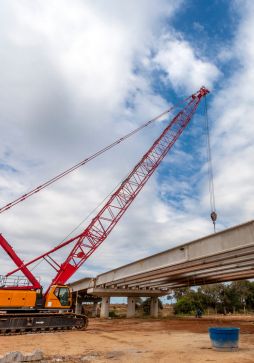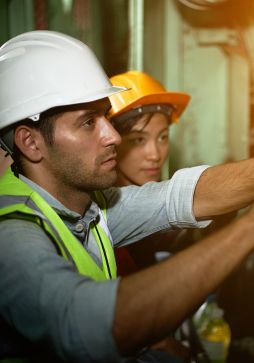The construction industry is set to experience significant transformations in 2024, driven by advancements in technology, sustainability initiatives, and changes in global supply chains. As these trends shape the future of construction, industry professionals must stay informed and adapt to stay competitive. From sustainable building practices to the rise of digital tools like Building Radar, the landscape is evolving rapidly. Companies that embrace these changes are better positioned to lead the market and win high-margin projects.
In this article, we’ll explore the key trends that will define the construction industry in 2024 and provide actionable insights to help businesses navigate these shifts. By understanding these trends and how tools like Building Radar’s AI technology can provide early project identification, your company can gain a competitive edge.
1. Sustainable Construction Practices
Sustainability continues to be a dominant trend in the construction industry. With stricter environmental regulations and an increasing focus on energy-efficient buildings, companies must adopt sustainable practices to remain relevant. Green building certifications like LEED and BREEAM are becoming industry standards, pushing contractors and developers to prioritize eco-friendly materials and energy-efficient systems.
Sustainable construction doesn’t just reduce environmental impact—it also offers long-term cost savings. Energy-efficient buildings use less power, reducing operating expenses, while eco-friendly materials tend to be more durable and require less maintenance. As demand for sustainable buildings grows, platforms like Building Radar can help companies track new projects focused on sustainability, enabling them to position their services to meet this increasing demand.
2. Increased Use of Modular Construction
Modular construction, where buildings are constructed off-site and assembled on-site, is gaining popularity due to its efficiency and cost-effectiveness. In 2024, we expect to see an even greater adoption of this method as it reduces construction time, labor costs, and waste. Modular construction also allows for better quality control since building components are produced in a controlled factory environment.
With modular construction gaining traction, companies can stay ahead by identifying new modular projects early. Tools like Building Radar’s project tracking software offer real-time insights, allowing businesses to discover these projects and make strategic bids before their competitors.
3. Digital Transformation in Construction
The construction industry has traditionally been slow to adopt digital tools, but that is changing. In 2024, digital transformation will play a crucial role in optimizing processes, from project management to sales and customer relationship management. Digital platforms, cloud-based solutions, and advanced AI tools are becoming essential for improving operational efficiency, reducing costs, and increasing project accuracy.
Platforms like Building Radar leverage AI to identify new construction opportunities earlier than traditional methods. This early detection allows sales teams to focus on high-potential projects and maximize their chances of success. Additionally, Building Radar’s seamless CRM integration helps streamline lead management and optimize the sales process, saving time and resources.
4. Smart Cities and IoT Integration
Smart city development is another major trend to watch in 2024. With urbanization on the rise, cities are increasingly turning to smart technologies to improve infrastructure, reduce traffic congestion, and enhance energy efficiency. The integration of the Internet of Things (IoT) in construction projects allows for real-time monitoring of building performance, predictive maintenance, and better resource management.
As smart city projects grow in number, construction companies need to be prepared to deliver projects that incorporate these technologies. Platforms like Building Radar provide valuable insights into upcoming smart city initiatives, enabling businesses to tailor their services to meet the demands of these high-tech projects.
5. Labor Shortages and Workforce Development
Labor shortages have been a persistent issue in the construction industry, and the problem is expected to continue in 2024. The aging workforce and lack of new talent entering the industry are causing delays in project completion and increasing costs. To combat this challenge, companies are investing in workforce development, training programs, and automation technologies to reduce reliance on manual labor.
By tracking labor trends and identifying projects that require specific skill sets, platforms like Building Radar can help companies adapt to these changes. With features like AI-driven recommendations, Building Radar ensures that sales teams focus on projects where they have the best chances of winning, optimizing both time and resources.
6. Supply Chain Resilience and Local Sourcing
The global pandemic exposed vulnerabilities in supply chains, and many construction companies are now looking for ways to make their supply chains more resilient. In 2024, we expect to see a shift towards local sourcing of materials to reduce dependence on international suppliers and minimize delays. This move towards local sourcing also supports sustainability efforts by reducing transportation emissions.
To stay competitive, companies must track local sourcing trends and position themselves as reliable suppliers of locally sourced materials. Platforms like Building Radar can help companies discover new projects that prioritize local suppliers, ensuring that businesses remain at the forefront of this growing trend.
7. AI and Robotics in Construction
Artificial Intelligence (AI) and robotics are set to revolutionize construction in 2024. AI tools are being used for everything from project planning and risk assessment to automating repetitive tasks on-site. Robotics, on the other hand, can handle tasks such as bricklaying, demolition, and site inspections with greater precision and speed than human workers.
AI-powered platforms like Building Radar are already changing the way construction companies identify new opportunities. With advanced AI technology, Building Radar helps companies spot new projects as soon as they enter the planning phase, giving them a first-mover advantage. Robotics and AI in construction are set to increase efficiency and safety, making them essential tools for the industry’s future.
How Building Radar Can Support These Trends
As the construction industry continues to evolve, companies need tools that help them adapt quickly to new trends. Building Radar offers an innovative solution for building product manufacturers and general contractors by enabling their sales teams to secure high-margin projects through effective specification development.
Building Radar’s AI-driven technology allows companies to identify new construction projects at the earliest stages, creating fresh sales opportunities. The platform provides a simple qualification process to help teams maximize conversion rates, while its streamlined sales process ensures that businesses spend more time selling and less time on manual administrative tasks.
With over 45 search filters, Building Radar ensures that users never miss a construction project. It integrates seamlessly with major CRM systems like Salesforce and HubSpot, helping companies uncover sales potential and streamline their processes. Additionally, Building Radar offers a scalable Revenue Engineering Software that turns projects into measurable revenue, making it a powerful tool for construction professionals looking to stay ahead in 2024.
Conclusion
The construction industry in 2024 will be shaped by sustainability, digital transformation, and advanced technologies like AI and robotics. Companies that embrace these trends will be better positioned to succeed in a highly competitive market. Platforms like Building Radar provide essential tools for identifying new projects, streamlining sales processes, and staying ahead of emerging trends.
By keeping an eye on the latest construction trends and leveraging the right technologies, businesses can not only stay competitive but also thrive in the changing landscape of the industry.









